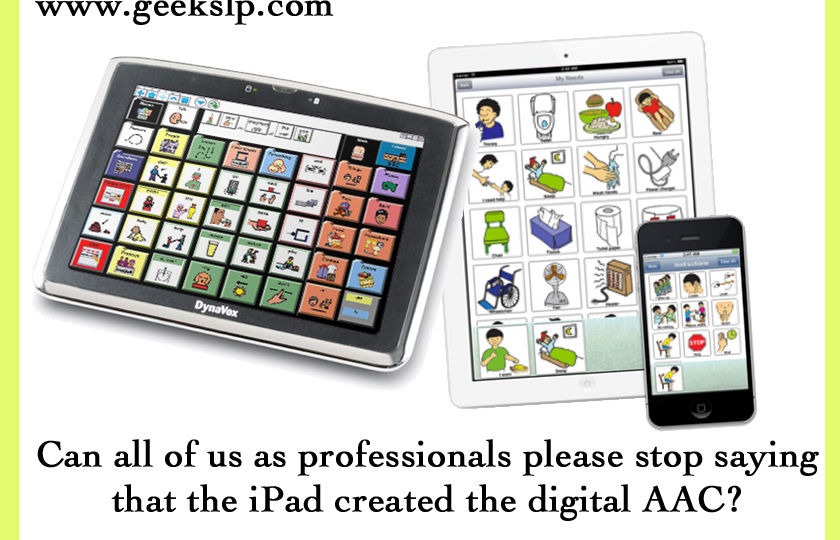
I have been meaning to write this blog post for such a long time, and with every new interview I see on television or read in the newspaper, the urge to correct this fallacy grows exponentially. Why is it that nearly every AAC app developer or professional being interviewed about the “miracle of the iPad as an AAC device” insists on saying that before the iPad apps, all that children had available to communicate was a set of paper based picture exchange communication cards?
Let’s agree on one thing, yes the iPad is for sure bringing a revolution in this field, but it cannot and should not take away the credit of its predecessors or invalidate the need for paper based picture exchange communication. Many people questioned my about where I saw this happen. Here is a video of one of the many times it has happened:
Most of you know me as an app developer and a speech pathologist. What most of you don’t know is that 8 years ago, I was providing services in Brazil, at a public institution when I received a grant to come to the US to learn about high-tech AAC devices and bring some solutions to Brazil. I remember that when I arrived in the US and started doing my internships at the various AAC service locations I was amazed by the various AAC devices available to children with limited communication skills. Before that, I spent 4 years in Brazil implementing AAC from pictures from Magazines (forget solutions like symbols! Even that was a nice discovery for me).
While professionals in the field should probably know that nobody miraculously came up with an AAC app that substituted paper based cards, people outside of the professional sphere are being led to believe that we went from cutting papers on a magazine to taping a symbol on the iPad and “giving the voice” to a children with speech delays. While this may be a reality for countries where AAC devices are not readily available in schools or even exist, this is definitely not true in the United States. I know this post is centered around a reality that may not be the same for other countries, especially some countries that are not English speaking. If an AAC app is now available in Portuguese, it may well be that children and professionals went from only having magazine cut outs to having a full AAC app.

Yes, the iPad has made digital alternative communication devices much more affordable, and this is by far one of the points we can credit the iPad for, which in consequence leads to benefiting children who were ready for a more advanced communication device but could not afford one. So, let’s make this point clear and easy… the AAC app you are using may have brought about a revolution on a child’s communication skills by allowing those who would not otherwise have access to a dynamic display device AAC device, or who were not interested in using one. So, at an individual level the iPad may have replaced the picture exchange communication symbols that were in paper format for children who had no access to a step up solution from the paper, but it came as an necessary evolution from existing AAC devices.
In sum, all I am trying to say is that the iPad has lots of benefits (which is a topic for another post) and has changed the lives of many children with autism and children with communication delays; but if you are going out and saying that you didn’t know of the fact that AAC devices with dynamic touch display existed prior to the iPad you should consider your skills in making children better communicators.



Nicely stated Barbara. I agree a disservice is done when people ignore the alternate forms of AAC. The iPad is a wondrous device – but it is not the only device and there are some people for whom it will not be the best device.
Bravo! Well said!
Eek. Irish example! Can’t stand that presenter.Don’t think that app is still available. I promise we had gotalks, dynavoz, chatpc4s, lightwriters etc in Ireland for years! well said!!!
Thank you for this – well said. It’s so silly – it’s like believng that the creator of the latest and coolest/fastest car actually invented the wheel! It is misleading (not to mention annoying and plain WRONG) when the media promote this false image of a world devoid of AAC until the iPad came along! But as we know, the media is often misleading, annoying and plain wrong. It is indeed much more worrying when professionals believe and/or actively promote the same misconception. And it is even more wrong when commercial suppliers of AAC apps also deliberately cash in on this misconception and even create dodgy ‘research’ to back it up. Naming no names.
In my view, the best AAC Apps (and the best revised versions of original AAC Apps) are those that have either copied features from existing AAC software (developed with many years of specialist expertise and incorporating user experience) or listened to what users tell them they need and want. Or both of those. The worst AAC Apps are those that AAC un-aware people have conjured ‘out of their heads’, often for one particular user (not a criticism, that’s what you’d expect). In other words, there is no revolutionary or innovatory practice embodied in Apps for AAC, there is simply a transfer of existing knowledge and good practice to a new and different hardware and software platform.
In my experience, many people who use AAC benefit from using BOTH a ‘traditional’ communication aid – often in educational and/or work settings – AND an iPad – more often at home, and ranging across not only communication but also independent entertainment and play and learning etc. I also see lchildren with autism using the iPad for lots of purposes, but although they may have an AAC app on there (amongst many other things).i t’s not always being used well (or at all). On we go!
> Why is it that nearly every AAC app developer… insists on saying that before the iPad apps, all that children had available to communicate was a set of… cards?
I’m sure people have said things like this, but I think the argument is a bit of a straw man.
In the video, McEvoy doesn’t say this. His closest comment comes around the [1:34 mark](http://cl.ly/IEDH).
> Up until this, Karl has been using these little books, symbol books, and he’s not very happy using them because they’re cumbersome.
He tells *his son’s* story about using his “trendy iPhone” instead of a book “because he didn’t want to carry [the book] around”.
Even if he did make a general claim, it’s still perfectly valid. Those in the know can quibble over semantics, but parents and children don’t care about what might’ve been available in the past. There’s an AAC revolution happening now, and it’s because of consumer-focused, general purpose, mobile devices.
The legacy goes to the ones who get the technology into the hands of people. Books have been [printed for a long time](http://cl.ly/ICyB), but [Gutenberg](http://cl.ly/IEBF) gets the credit. What good is a [revolutionary computer interface](http://cl.ly/ID60) until [somebody ships something real people can use](http://cl.ly/ID45)?
Thanks to all the AAC pioneers for providing the giants’ shoulders, but the kudos go to those who’ve seen further by standing on them. And there’s nothing wrong with that.
Sorry for the late comment. I actually got here when I was looking for AAC apps that had synthesized speech for portuguese speakers. If you know any I would appreciate any recommendations. But once here, I loved reading your post and did want to comment. You are certainly correct. It could be a little more than frustrating especially for those of us doing this for awhile. The good news though, is at least people are talking AAC and at least there is much less ‘convincing’ people of the benefits. What we could not do as a field before (especially in ASD) was to get people to understand the huge benefits. Now, the dilemma is convincing people to make evidence based decisions when they purchase AAC apps.
Robin,
Have you found any AAC apps including portuguese? If so, please share!
I hope all is well!
Amen! I’ve been using “electronic” AAC devices for almost 20 years. I’m tired of people seeing the iPad as the “cure-all” for everything! Are the innovations of the past decades not real? And of course there’s always someone on Oprah or whatever show saying that the iPad “cured” their child of autism! Ugh.